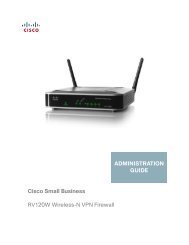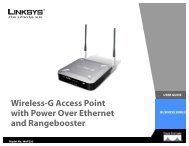Cisco Catalyst 6500 Supervisor 2T Architecture - Ipland
Cisco Catalyst 6500 Supervisor 2T Architecture - Ipland
Cisco Catalyst 6500 Supervisor 2T Architecture - Ipland
Create successful ePaper yourself
Turn your PDF publications into a flip-book with our unique Google optimized e-Paper software.
White PaperLayer 3 - Egress NetFlowPreviously, NetFlow was only supported for ingress data traffic. Egress NetFlow provides support for collecting flowstatistics for packets after they have had ingress processing applied to them, and prior to transmission out theegress interface or interfaces. This can be of value, especially for users wanting to collect flow statistics for datamoving into and out of a VPN, for example.Layer 3 - Sampled NetFlowSampled NetFlow is a new feature in the PFC4 that allows customers to opt for NetFlow records to be created basedon a sample of the traffic matching the flow. Sample Netflow uses a 1/N based sampling which inspects one packetevery N packets. The PFC3x was capable of performing sampling but the operation was performed after theinspection process. The PFC4 performs the sampling during the inspection process, effectively reducing the amountof NetFlow entries. There are 1 K global NetFlow samplers supported in PFC4.Layer 3 - MPLS NetFlowThe PFC4 provides support for aggregate label at the Provider Edge (PE). This feature allows the inspection of IPtraffic belonging to a particular VPN before it is added with a MPLS label (ip2mpls) and after the last label is removed(mpls2ip). The MPLS NetFlow also allows the inspection of the IP header for non aggregate label at a P device(mpls2mpls).Layer 3 - Layer 2 NetflowThe layer 2 Netflow feature in the PFC4 allows Netflow lookups for IPv4, IPv6 and MPLS based packets to beperformed using the Layer 2 header.Layer 3 - Flexible NetFlowThe PFC4 now supports Flexible NetFlow (FnF), based on the NetFlow v9 record format. FnF allows users moreflexibility in defining which record types they want to use for a v9 record. More importantly, FnF now also includes anumber of new field options to allow for collection of MPLS, IPv6, and multicast information in a NetFlow record.Layer 3 - Distributed PolicingIn a PFC3x-based system using DFC3s, an aggregate policer applied on a VLAN that included ports on differentDFC3-enabled linecards could not synchronize their token buckets. As such, each DFC3-enabled linecard wouldmaintain its own aggregate policed count, resulting in the true aggregate rate being multiplied by the number ofDFC3s which apply the policer.PFC4 solves this problem with the introduction of the distributed policer. This allows the policing state to besynchronized across multiple DFC4-enabled linecards providing for multi-port multi-module policing. A total of 1 Kdistributed policers are supported with PFC4.Layer 3 - DSCP MutationQuality of Service (QoS) support in PFC4 is enhanced with its support for multiple ingress and egress DifferentiatedServices Code Point (DSCP) mutation maps. A DSCP mutation map is a table that defines to what an existing DSCPvalue in a packet can be modified. DSCP mutation maps facilitate the marking (or reprioritizing of packets) process.Up to 14 ingress DSCP mutation maps and up to 16 egress DSCP mutation maps can be defined in the PFC4.Layer 3 - Aggregate PolicersAn aggregate policer is a rate limiting policy that can be applied to a port, group of ports, VLAN or group of VLANsthat limits total traffic through those ports/VLANs to a predetermined bandwidth amount. Traffic in excess of the limitcan either be marked down and forwarded, or dropped. The previous PFC3x forwarding engine supported amaximum of 1023 aggregate policers per chassis. PFC4 increases the limit on aggregate policers supported to 6 K.© 2011-2012 <strong>Cisco</strong> and/or its affiliates. All rights reserved. This document is <strong>Cisco</strong> Partner Confidential Information. Page 22 of 46
















